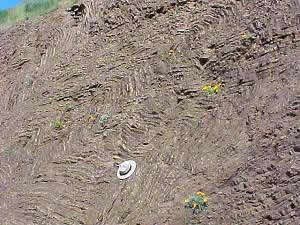
Will Elder, NPS Highly folded bedded chert is a characteristic rock of the Franciscan Complex. The folding is largely due to deformation produced as the oceanic sediments were scraped off the subducting Pacific Plate and accreted to the North American continental margin at the subduction zone. In the Franciscan Complex, chert is a silica-rich rock formed from the altered shells of microscopic radiolaria, which slowly rained down onto the ocean bottom. Bedded chert is only developed in deep ocean settings, where few mud particles from the continents are present to dilute the silica. Chert is also typically formed under areas of high productivity in the oceans, which promotes the growth of radiolaria relative to other types of plankton. The thin beds or layers may be due to changes in oceanic silica productivity associated with the Earth's orbital cycles. The red color reflects the how much oxygen was present when the rock formed. 
(0.5 to 1.5 mm) silica shells of radiolaria. Many of these radiolaria are tropical species indicating that the sediments were deposited near the equator and were later transported northeastward by plate movements. |
Last updated: February 28, 2015
